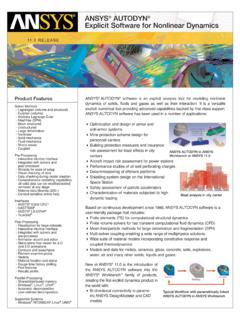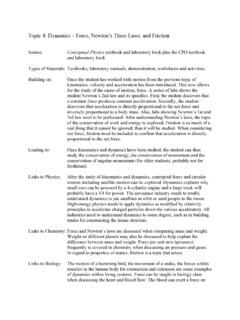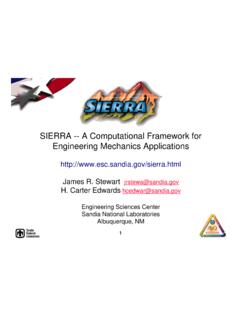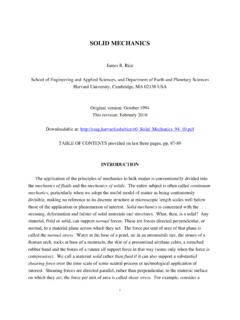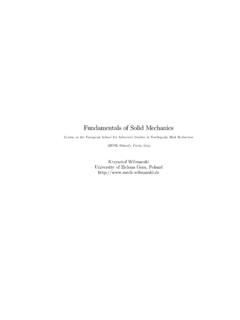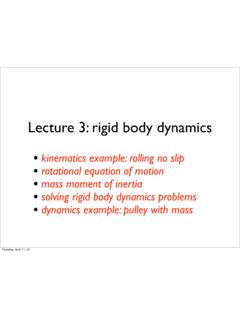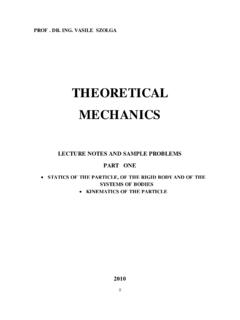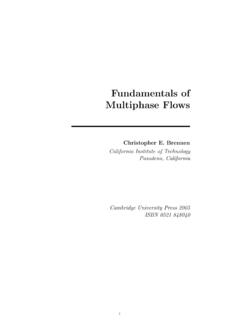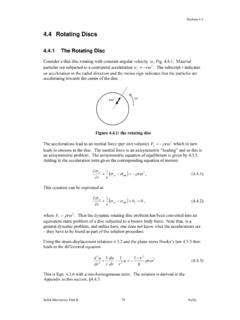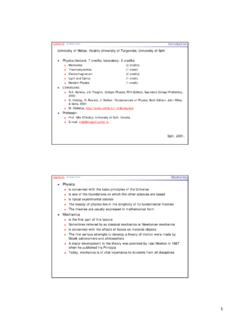Transcription of 93 - Food and Agriculture Organization
1 93. Chapter 6. Basic mechanics Basic principles of statics All objects on earth tend to accelerate toward the Statics is the branch of mechanics that deals with the centre of the earth due to gravitational attraction; hence equilibrium of stationary bodies under the action of the force of gravitation acting on a body with the mass forces. The other main branch dynamics deals with (m) is the product of the mass and the acceleration due moving bodies, such as parts of machines. to gravity (g), which has a magnitude of m/s2: Static equilibrium F = mg = v g A planar structural system is in a state of static equilibrium when the resultant of all forces and all where: moments is equal to zero, F = force (N).
2 M = mass (kg). g = acceleration due to gravity ( ). y Fx = 0 Fx = 0 Fy = 0 Ma = 0 v = volume (m ). Fy = 0 or Ma = 0 or Ma = 0 or Mb = 0 = density (kg/m ). x Ma = 0 Mb = 0 Mb = 0 Mc = 0. Vector where F refers to forces and M refers to moments of Most forces have magnitude and direction and can be forces. shown as a vector. The point of application must also be specified. A vector is illustrated by a line, the length of Static determinacy which is proportional to the magnitude on a given scale, If a body is in equilibrium under the action of coplanar and an arrow that shows the direction of the force.
3 Forces, the statics equations above must apply. In general, three independent unknowns can be determined from Vector addition the three equations. Note that if applied and reaction The sum of two or more vectors is called the resultant. forces are parallel ( in one direction only), then only The resultant of two concurrent vectors is obtained by two separate equations can be obtained and thus only constructing a vector diagram of the two vectors. two unknowns can be determined. Such systems of The vectors to be added are arranged in tip-to-tail forces are said to be statically determinate.
4 Fashion. Where three or more vectors are to be added, they can be arranged in the same manner, and this is Force called a polygon. A line drawn to close the triangle A force is defined as any cause that tends to alter the or polygon (from start to finishing point) forms the state of rest of a body or its state of uniform motion resultant vector. in a straight line. A force can be defined quantitatively The subtraction of a vector is defined as the addition as the product of the mass of the body that the force is of the corresponding negative vector.
5 Acting on and the acceleration of the force. P = ma P. where P = applied force m = mass of the body (kg). a = acceleration caused by the force (m/s2). The Syst me Internationale (SI) units for force are Q. therefore kg m/s2, which is designated a Newton (N). The following multiples are often used: A. 1 kN = 1 000 N, 1 MN = 1 000 000 N. 94 Rural structures in the tropics: design and development Q Concurrent coplanar forces P Forces whose lines of action meet at one point are said to be concurrent.
6 Coplanar forces lie in the same plane, whereas non-coplanar forces have to be related to a three-dimensional space and require two items Q of directional data together with the magnitude. Two +. P coplanar non-parallel forces will always be concurrent. =. R. Equilibrium of a particle When the resultant of all forces acting on a particle is A. zero, the particle is in equilibrium, it is not disturbed P from its existing state of rest (or uniform movement). The closed triangle or polygon is a graphical expression of the equilibrium of a particle.
7 Q The equilibrium of a particle to which a single force +. P is applied may be maintained by the application of a =. R second force that is equal in magnitude and direction, but opposite in sense, to the first force. This second force, which restores equilibrium, is called the equilibrant. Q When a particle is acted upon by two or more forces, the A equilibrant has to be equal and opposite to the resultant of the system. Thus the equilibrant is the vector drawn closing the vector diagram and connecting the finishing Q point to the starting point.
8 P. P. S. S. Q+. P+. R=. A. Q. Resolution of a force A. In analysis and calculation, it is often convenient to consider the effects of a force in directions other than Q. P. that of the force itself, especially along the Cartesian (xx-yy) axes. The force effects along these axes are called vector components and are obtained by reversing the vector addition method. T. T AN. S UL. RE. y A. Q. F. P. Fy NT. B RA. x LI. 0 Fx UI. EQ. Fy is the component of F in the y direction Fy = F sin . Fx is the component of F in the x direction Fx = F cos A.
9 A. Chapter 6 Basic mechanics 95. 980 N. Free body diagram for point A. Free-body diagram of a particle A sketch showing the physical conditions of a problem is known as a space diagram. When solving a problem it TAB. is essential to consider all forces acting on the body and 980 N. to exclude any force that is not directly applied to the body. The first step in the solution of a problem should therefore be to draw a free-body diagram. TAC. A free-body diagram of a body is a diagrammatic representation or a sketch of a body in which the body is shown completely separated from all surrounding bodies, including supports, by an imaginary cut, and the action of each body removed on the body being Example considered is shown as a force on the body when A rigid rod is hinged to a vertical support and held drawing the diagram.
10 At 50 to the horizontal by means of a cable when a To draw a free-body diagram: weight of 250 N is suspended as shown in the figure. 1. Choose the free body to be used, isolate it from Determine the tension in the cable and the compression any other body and sketch its outline. in the rod, ignoring the weight of the rod. 2. Locate all external forces on the free body and clearly mark their magnitude and direction. This should include the weight of the free body, which A. 75 . is applied at the centre of gravity.










